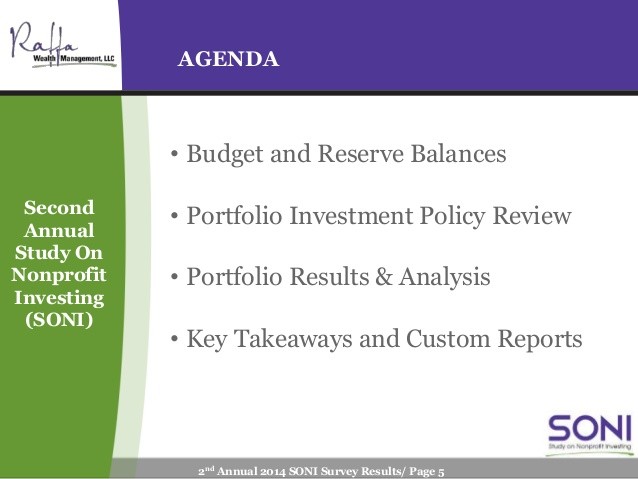Nonprofit Investment Policy
Post on: 3 Июль, 2015 No Comment

Ten Tips to Help Your Organization Protect Its Investments
A nonprofit organization’s investments can be its lifeblood, allowing the group to maintain services or supplement its day-to-day income. Or investments can provide the insurance that an organization has long-term financial security. However your group uses investment income, it’s important to take steps to protect it.
1. Have people on your finance committee with financial experience. Whether they come from a banking, investment or business owner background, having professionals with an understanding of finance will greatly help your board of trustees understand its financial situation and work toward sound financial decisions. It is important to establish a balance of talent on your organization’s board between those who understand and are passionate about the organization’s mission programs and those who have financial expertise to help carry out the mission.
2. Have a clear mission and objectives for the organization. It may sound simple, but before a nonprofit organization can begin to work on investment decisions, the group must establish a clear mission and objectives. Sometimes organizations have an informal mission that many not be well communicated or even shared by all those involved. By developing a formal, written mission and objectives, everyone understands the purpose of the organizations and what programs and services it will provide. With a clearly defined mission, the organization can then begin considering the financial resources that will be needed to carry out its purpose.
3. Develop an investment policy. The group’s board of trustees should have a written investment policy. The policy is your roadmap or business plan for making critical investment decisions. It should detail how investment funds will be allocated, what return threshold will trigger action and explain the group’s short-term, medium-term and long-term investment philosophy. If your organization created an investment policy five or ten years ago, it’s time to look at it again. An investment policy should be reviewed annually and updated to reflect current trends. The investing world has changed dramatically in the past few years, and your investment policy should, too.
4. Develop a process for considering investment managers. The group’s trustees should determine who is eligible to become an investment manager for the organization. Is eligibility based on the investment manager being local? Does it require the manager to have prior experience helping nonprofit organizations invest? Trustees should put in writing the qualities that it values in an investment manager. The list might include the experience, background and qualifications of principals and portfolio managers, management philosophy and methodology, completeness of strategy and objectives. flexibility and diversity of investments, quality control, performance, availability of electronic information and analysis data, flexibility of contractual agreement or process for transferring funds.
Sometimes larger organizations develop a request for proposal process. In the RFP the organization might ask, for example, for providers to explain their investment strategy, list management fees or describe the specific types of investments they would recommend. The RFP can allow the organization to better compare among providers in a head-to-head comparison those elements of service that are most important to the group.
5. Create a spending policy. Many organizations have faced increasing cost-cutting measures including cutting services and staff, even while they might maintain millions of dollars in reserve. The board must determine under what circumstances the organization has the ability to spend its reserves to continue its mission.
6. Establish a review process. The written investment policy should spell out how often investments will be reviewed. A review should occur at least annually, but might include monthly or quarterly updates. Many investment companies offer online access to statements, and the board may choose to provide specific board and/or staff members access to view the online statements (although not necessarily to make transfers.) The organization should also document its completion of the review process through meeting minutes.
7. Determine who is in charge. The investment policy should also determine who can make investment decisions, and who may contact the broker to make trades for the organization’s investments. The investment policy should outline the decision-making process and provide a threshold of return below which investments will be sold or traded.
8. Communicate regularly with the broker. An organization’s investments can sometimes become a document that is placed on a shelf and forgotten about. Don’t let this happen to your group’s investments. The investment policy should determine who will represent the organization in regular communication with the broker.

9. Set expectations. Finally, an organization’s investment policy should outline the group’s investment expectations. Will the group’s investments work to beat inflation? Beat the S&P 500? By putting the organization’s investment goals in writing, all members have a similar understanding of what to expect.
10. Take stewardship seriously. It should go without saying that as board members consider the options of investing an organization’s assets, they must be good stewards for the organization and make decisions that are in the best interest of the organization and meeting its mission. This includes closely monitoring management fees as well as the estimated rate of return on the investments. When a well-written investment policy is in place, board members have better guidance to help them make sound investment decisions.
Your organization’s investments are an important part of its financial stability. By developing a clear investment policy, your group will be more likely to achieve its financial goals.
Contact Reas Not-for-Profit Services Team
Does your organization need more than ten tips to get its investments sorted out? Feeling that your investment policy and communication could use some improvement? Contact Rea & Associates. Reas non-for-profit services team brings not-for-profit financial management experience. Well help you protect your investments, putting in place the policies that you need to safe guard your finances. Well manage your investment policy so you can get back to managing your organization.
This entry was posted on Friday, June 22nd, 2012 at 7:59 pm and is filed under Not-For-Profit. You can follow any responses to this entry through the RSS 2.0 feed. You can leave a response. or trackback from your own site.














